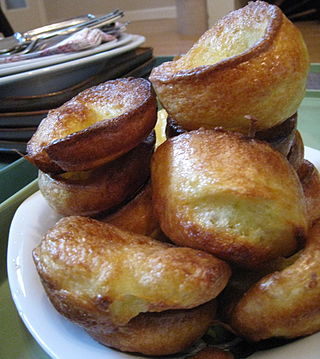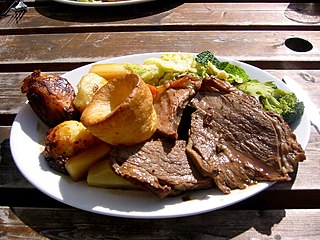Related Research Articles

Yorkshire pudding is a baked pudding made from a batter of eggs, flour, and milk or water. A common British side dish, it is a versatile food that can be served in numerous ways depending on its ingredients, size, and the accompanying components of the meal. As a first course, it can be served with onion gravy. For a main course, it may be served with meat and gravy, and is part of the traditional Sunday roast, but can also be filled with foods such as bangers and mash to make a meal. Sausages can be added to make toad in the hole. The 18th-century cookery writer Hannah Glasse was the first to use the term "Yorkshire pudding" in print.

A Sunday roast or roast dinner is a traditional meal of British origin. Although it can be consumed throughout the week, it is traditionally consumed on Sunday. It consists of roasted meat, mashed potatoes, roasted potatoes and accompaniments such as Yorkshire pudding, stuffing, gravy, and condiments such as apple sauce, mint sauce, or redcurrant sauce. A wide range of vegetables can be served as part of a roast dinner, such as broccoli, Brussels sprouts, cabbage, carrots, cauliflower, parsnips, or peas, which can be boiled, steamed, or roasted alongside the meat and potatoes.

Pudding is a type of food. It can be either a dessert or a savoury dish served as part of the main meal.

Spotted dick is a traditional British steamed pudding, historically made with suet and dried fruit and often served with custard.

Christmas pudding is sweet dried-fruit pudding traditionally served as part of Christmas dinner in Britain and other countries to which the tradition has been exported. It has its origins in medieval England, with early recipes making use of dried fruit, suet, breadcrumbs, flour, eggs and spice, along with liquid such as milk or fortified wine. Later, recipes became more elaborate. In 1845, cookery writer Eliza Acton wrote the first recipe for a dish actually called "Christmas pudding".

Chocolate puddings are a class of desserts in the pudding family with chocolate flavors. There are two main types: a boiled then chilled dessert, texturally a custard set with starch, commonly eaten in the U.S., Canada, Germany, Sweden, Poland, and East and South East Asia; and a steamed/baked version, texturally similar to cake, popular in the UK, Ireland, Australia, Germany and New Zealand.

Apple crisp is a dessert made with a streusel topping. In the US and Canada, it is also called apple crumble, a word which refers to a different dessert in the UK, Australia, and New Zealand.

Czech cuisine has both influenced and been influenced by the cuisines of surrounding countries and nations. Many of the cakes and pastries that are popular in Central Europe originated within the Czech lands. Contemporary Czech cuisine is more meat-based than in previous periods; the current abundance of farmable meat has enriched its presence in regional cuisine. Traditionally, meat has been reserved for once-weekly consumption, typically on weekends.

Scottish cuisine encompasses the cooking styles, traditions and recipes associated with Scotland. It has distinctive attributes and recipes of its own, but also shares much with other British and wider European cuisine as a result of local, regional, and continental influences—both ancient and modern.

Cabinet pudding, also known as chancellor's pudding or Newcastle pudding, is a traditional English steamed, sweet, moulded pudding made from some combination of bread or sponge cake or similar ingredients in custard, cooked in a mould faced with decorative fruit pieces such as cherries or raisins, served with some form of sweet sauce. Other versions of cabinet pudding might use gelatin and whipped cream.

Sponge cake is a light cake made with egg whites, flour and sugar, sometimes leavened with baking powder. Some sponge cakes do not contain egg yolks, like angel food cake, but most of them do. Sponge cakes, leavened with beaten eggs, originated during the Renaissance, possibly in Spain. The sponge cake is thought to be one of the first of the non-yeasted cakes, and the earliest attested sponge cake recipe in English is found in a book by the English poet Gervase Markham, The English Huswife, Containing the Inward and Outward Virtues Which Ought to Be in a Complete Woman (1615). Still, the cake was much more like a cracker: thin and crispy. Sponge cakes became the cake recognized today when bakers started using beaten eggs as a rising agent in the mid-18th century. The Victorian creation of baking powder by English food manufacturer Alfred Bird in 1843 allowed the addition of butter to the traditional sponge recipe, resulting in the creation of the Victoria sponge. Cakes are available in millions of flavours and have many recipes as well. Sponge cakes have become snack cakes via the Twinkie.

Poutchine au sac is a bag pudding and a Métis dish made of beef suet, flour, brown sugar, raisins, currants, and milk. The ingredients are combined in a cotton bag or sealer jars, then steamed. The cooked dish is usually topped with a sauce made from sugar, cornstarch, vanilla and nutmeg.
References
- ↑ Paston-Williams, Sara (2002). Traditional Puddings (2nd ed.). The National Trust. p. 121. ISBN 0-7078-0308-X.
- ↑ Xanthe Clay Great British puddings - full steam ahead May 2, 2008